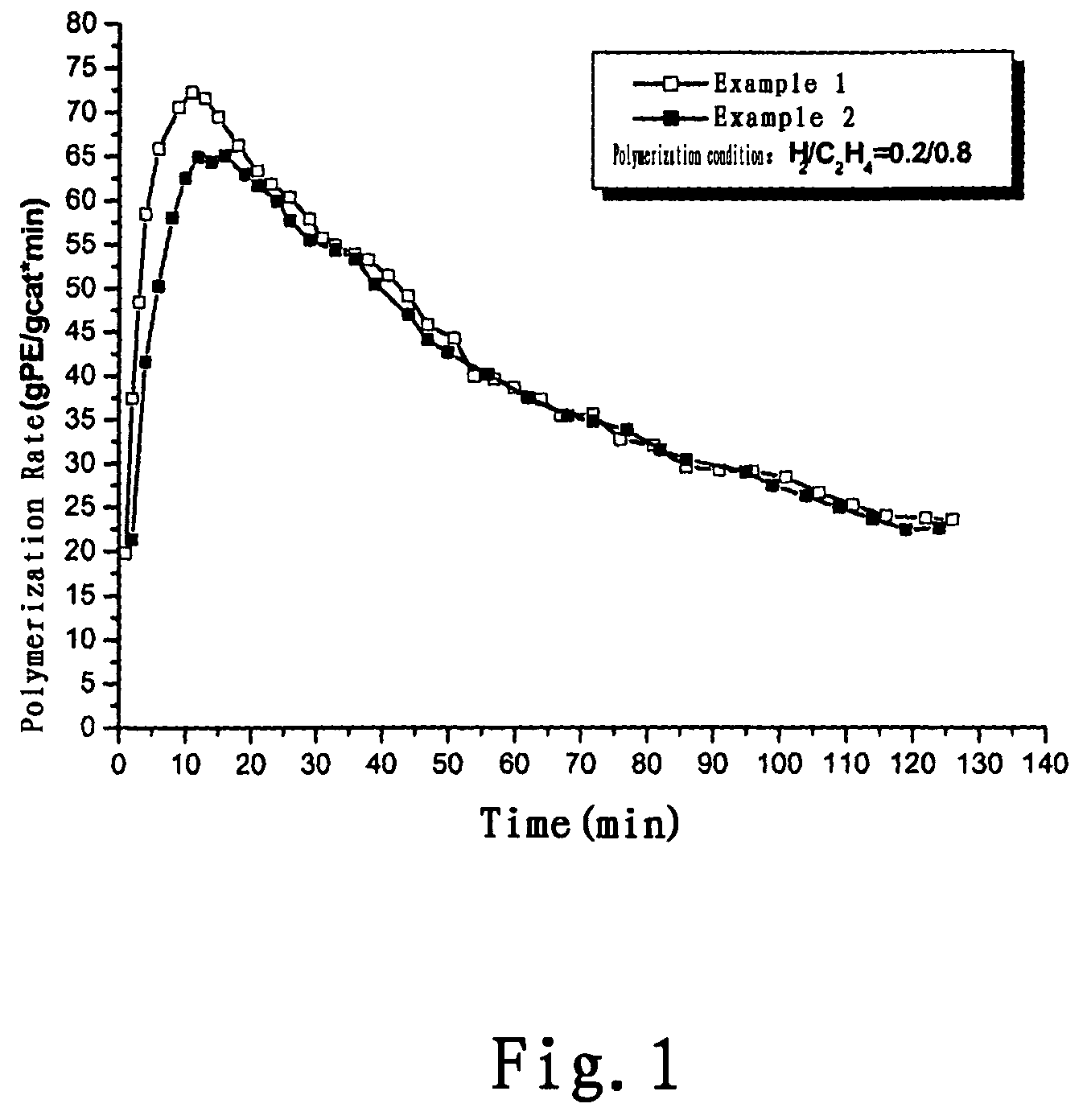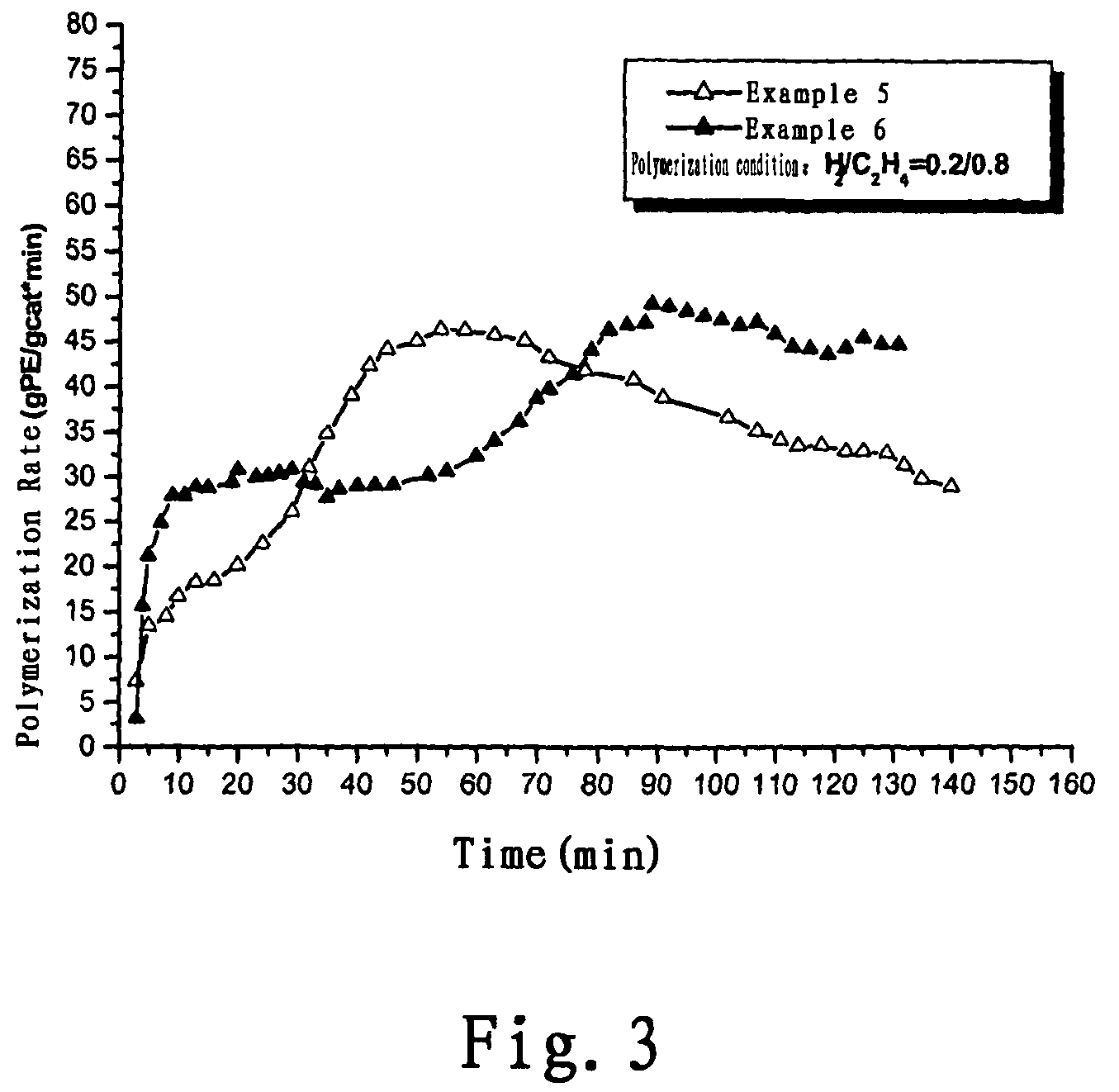Catalyst for ethylene polymerization, preparation thereof, and method for controlling the polymerization kinetic behavior of said catalyst
a technology of ethylene polymerization and catalyst, which is applied in the direction of catalyst activation/preparation, physical/chemical process catalyst, chemical/physical process, etc., and can solve problems such as not being disclosed or suggested
- Summary
- Abstract
- Description
- Claims
- Application Information
AI Technical Summary
Benefits of technology
Problems solved by technology
Method used
Image
Examples
example 1
Preparation of Catalyst
[0066](1) Preparation of the hydrocarbon solution of dibutylmagnesium compound (C4H9)2Mg.yEt3Al
[0067]6.12 g of a commercially available magnesium powder and 250 ml of heptane were charged into a 500 ml reaction flask, and were heated to the reflux temperature under stirring. Then 0.05 g of iodine and 1.0 ml of n-butyl chloride were added to the reaction flask, and the reaction was maintained for 1 hour. Then 19.5 g of n-butyl chloride was added dropwise by a constant pressure dropping funnel over 3 hours, and then the reaction was maintained for 2 hours. Next, 2.1 ml of triethylaluminum was added, and the reaction was maintained for further 2 hours. After the reaction was completed, the reaction system was cooled to about 50° C. and filtered under the protection of nitrogen gas, and the filter cake was washed with fresh heptane for several times. The obtained filtrate was concentrated by evaporating a portion of heptane, to give a heptane solution of (C4H9)2Mg...
example 2
Preparation of Catalyst
[0076](1) The heptane solution of dibutylmagnesium compound (C4H9)2Mg.0.21Et3Al with a magnesium content of 1.044 mol / L as prepared in Example 1 was used.
[0077](2) Silica (Grace Davison 955) was heated to 650° C. under a fluidized state in a nitrogen gas flow, and held at this temperature for 10 hours, then the silica was gradually cooled to room temperature.
[0078]In a 250 ml reaction flask, 7.14 g of the thermally activated silica was slurried in 40 ml of hexane. 8 ml of the heptane solution of (C4H9)2Mg.0.21Et3Al as prepared in step (1) was added thereto in one batch, and then the reaction was maintained at 35° C. for 3 hours.
[0079](3) To the slurry formed in step (2) was added 5.44 g of 50 wt. % solution of 2-ethylhexanol in hexane via a constant pressure dropping funnel over 40 minutes. The reaction was maintained at 40° C. for 4 hours.
[0080](4) To the slurry formed in step (3) were added 0.22 ml of ethylaluminum dichloride and 3.10 g of n-butyl chloride, ...
example 3
Preparation of Catalyst
[0084](1) Preparation of a hydrocarbon solution of dibutylmagnesium compound (C4H9)2Mg.yEt3Al
[0085]The procedure as described in Example 1 was followed, except for that the amount of triethylaluminum was changed to 3.5 ml, thus a heptane solution of (C4H9)2Mg.0.344Et3Al having a magnesium content of 1.016 mol / L was finally obtained.
[0086](2) Silica (Grace Davison 955) was heated to 600° C. under a fluidized state in a nitrogen gas flow, and held at this temperature for 10 hours, then the silica was gradually cooled to room temperature.
[0087]In a 250 ml reaction flask, 7.0 g of the thermally activated silica was slurried in 40 ml of hexane. 18 ml of the heptane solution of (C4H9)2Mg.0.344Et3Al as prepared in step (1) was added thereto in one batch, and then the reaction was maintained at 35° C. for 3 hours.
[0088](3) To the slurry formed in step (2) was added 10.68 g of 50 wt. % solution of 2-ethylhexanol in hexane via a constant pressure dropping funnel over 40...
PUM
| Property | Measurement | Unit |
|---|---|---|
| molar ratio | aaaaa | aaaaa |
| molar ratio | aaaaa | aaaaa |
| temperature | aaaaa | aaaaa |
Abstract
Description
Claims
Application Information
 Login to View More
Login to View More - R&D
- Intellectual Property
- Life Sciences
- Materials
- Tech Scout
- Unparalleled Data Quality
- Higher Quality Content
- 60% Fewer Hallucinations
Browse by: Latest US Patents, China's latest patents, Technical Efficacy Thesaurus, Application Domain, Technology Topic, Popular Technical Reports.
© 2025 PatSnap. All rights reserved.Legal|Privacy policy|Modern Slavery Act Transparency Statement|Sitemap|About US| Contact US: help@patsnap.com



